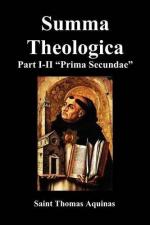Another sacrifice was the “sin-offering,” which was offered to God on account of man’s need for the forgiveness of sin: and this typifies the state of penitents in satisfying for sins. It was divided into two parts: for one part was burnt; while the other was granted to the use of the priests to signify that remission of sins is granted by God through the ministry of His priests. When, however, this sacrifice was offered for the sins of the whole people, or specially for the sin of the priest, the whole victim was burnt up. For it was not fitting that the priests should have the use of that which was offered for their own sins, to signify that nothing sinful should remain in them. Moreover, this would not be satisfaction for sin: for if the offering were granted to the use of those for whose sins it was offered, it would seem to be the same as if it had not been offered.
The third kind of sacrifice was called the “peace-offering,” which was offered to God, either in thanksgiving, or for the welfare and prosperity of the offerers, in acknowledgment of benefits already received or yet to be received: and this typifies the state of those who are proficient in the observance of the commandments. These sacrifices were divided into three parts: for one part was burnt in honor of God; another part was allotted to the use of the priests; and the third part to the use of the offerers; in order to signify that man’s salvation is from God, by the direction of God’s ministers, and through the cooperation of those who are saved.
But it was the universal rule that the blood and fat were not allotted to the use either of the priests or of the offerers: the blood being poured out at the foot of the altar, in honor of God, while the fat was burnt upon the altar (Lev. 9:9, 10). The reason for this was, first, in order to prevent idolatry: because idolaters used to drink the blood and eat the fat of the victims, according to Deut. 32:38: “Of whose victims they eat the fat, and drank the wine of their drink-offerings.” Secondly, in order to form them to a right way of living. For they were forbidden the use of the blood that they might abhor the shedding of human blood; wherefore it is written (Gen. 9:4, 5): “Flesh with blood you shall not eat: for I will require the blood of your lives”: and they were forbidden to eat the fat, in order to withdraw them from lasciviousness; hence it is written (Ezech. 34:3): “You have killed that which was fat.” Thirdly, on account of the reverence due to God: because blood is most necessary for life, for which reason “life” is said to be “in the blood” (Lev. 17:11, 14): while fat is a sign of abundant nourishment. Wherefore, in order to show that to God we owe both life and a sufficiency of all good things, the blood was poured out, and the fat burnt up in His honor. Fourthly, in order to foreshadow the shedding of Christ’s blood, and the abundance of His charity, whereby He offered Himself to God for us.




